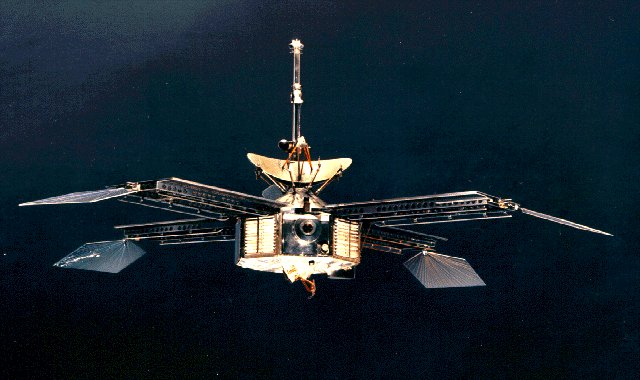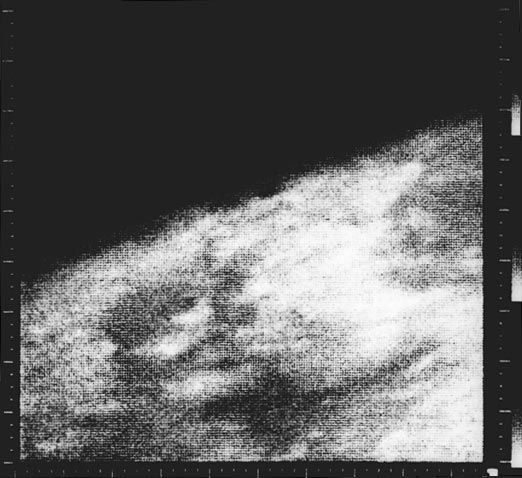
The first digital image from Mars, images at different stages of processing, double size. Image: Piotr A. Masek
On July 15, 1965, NASA spaceprobe Mariner 4 performed the first successful flyby of the planet Mars, returning the first pictures of the Martian surface. It captured the first images of another planet ever returned from deep space; their depiction of a cratered, seemingly dead world largely changed the view of the scientific community of life on Mars.
Failed Trials
The two Soviet probes Marsnik 1 and 2 were launched in October 1960 to fly past Mars, but did not even reach Earth orbit. In 1962 three more Soviet probes (Sputnik 22, Mars 1 and Sputnik 24) failed, two of them remained in Earth orbit, the third lost contact with Earth on its way to Mars. Another attempt in 1964 also failed. Mariner 3 and Mariner 4 were identical probes that were supposed to fly past Mars. Mariner 3 was launched on November 5, 1964, but the transport fairing did not come off properly and the probe did not reach Mars.
The Mariner 4 Mission
Mariner 4 was already the fourth in a series of spacecraft to explore planets in our solar system in the so called flyby mode. Mariner 4 was launched on November 28, 1964 and next to returning the first pictures of Mars, performing field and particle measurements in interplanetary space and providing experience in the engineering capabilities for interplanetary flights of long duration belonged to its mission objectives.
Reaching Mars
On July 15, 1965 the spacecraft flew by Mars and on that day Mariner’s camera sequence started as well. 21 pictures using alternate red and green filters, plus 21 lines of a 22nd picture were taken. The images represented about 1% of planet Mars’ surface and the closest approach was 9,846 km from the Martian surface. The pictures were stored in the on-board tape recorder. When Mariner 4 passed behind Mars, the radio signal ceased and was reacquired when the spacecraft reappeared. The transmission of the tapes started about 8 hours after signal reacquisition and continued until August 3. Mariner 4 successfully transmitted data from launch until October 1, 1965, when a temporary loss of communication with the spacecraft occurred until 1967.

Mariner 4 space probe
A Pastel Set from Art Supply…
In order to guarantee that the Mariner 4 camera was functioning correctly, the team decided to test its functionality, which led to the first digital image being hand-drawn. While waiting for the image data to be computer processed, the team used a pastel set from an art supply store to hand-color a numerical printout of the raw pixels. The resulting image provided early verification that the camera was functioning. The hand-drawn image compared favorably with the processed image when it became available.
Collecting 600KB of Data
Mariner 4 returned around 634 kB of data and the mission is considered an overall success. The images returned showed a Moon-like cratered terrain, which later missions showed was not typical for Mars, but only for the more ancient region imaged by Mariner 4. A surface atmospheric pressure of 410 to 700 pascals and daytime temperatures of −100 degrees Celsius were estimated. No magnetic field or Martian radiation belts were detected. The thin atmosphere and its craters indicated a relatively inactive planet exposed to the harshness of space, generally dissipated hopes of finding intelligent life on Mars. The solar wind was measured, and compared with simultaneous records from Mariner 5 which went to Venus.

The first close-up of Mars, taken by Mariner 4
Communication terminated
In December 1967, communications with Mariner 4 were terminated and the spaceprobe is now lost somewhere in an exterior heliocentric orbit. In 1969 followed Mariner 6 and Mariner 7 and delivered a total of 200 photos. 1971 the launch of Mariner 8 failed, but NASA received several thousand pictures from Mariner 9 in the same year. In the 1970s, the Viking probes successfully landed on Mars and provided the first colour images and data from soil samples: Viking 1 was the first US probe to make a soft landing on July 20, 1976. The Soviet Union tried further landings on Mars, but failed.[4]
References and Further Reading:
- [1] Mariner 4 Mission Profile at NASA
- [2] First TV Image of Mars – Interplanetary color by numbers
- [3] Mariner 4 at Space.com
- [4] Viking 1 and the Mission to Mars, SciHi Blog
- [5] Mariner 4 at Wikidata
- [6] 1965: Discovery at Mars, NASA Jet Propulsion Laboratory @ youtube
- [7] Momsen, Bill (2006). “Mariner IV – First Flyby of Mars: Some personal experiences”
- [8] Granath, Bob (November 4, 2014). “MAVEN Continues Mars Exploration Begun 50 Years Ago by Mariner 4”. nasa.gov. NASA.
- [9] Good, Dan. “Mariner 4 paint-by-number”. JLP/Caltech. NASA.
- [10] “Mariner to Mercury, Venus and Mars”. Jet Propulsion Laboratory. Fact Sheets. NASA. May 1996.
- [11] Timeline of space probes, via Wikidata





